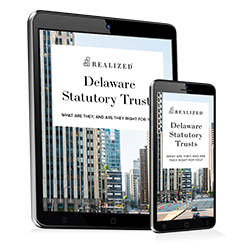
We’ve published several articles about Delaware Statutory Trusts (DSTs), including the advantages and disadvantages. DSTs let investors enjoy the potential benefits of real estate - rental income, appreciation, tax benefits - without having to have operational control or management of the property. We’re going to take another look at the pros and cons but in relation to debt-free versus leveraged DSTs.
Debt-Free DSTs
While many choose to go the route of having a leveraged DST for its benefits, buying investment real estate without debt is considered one of the safest ways to own real estate. Debt-free DSTs are for those who don’t want to deal with another mortgage and the risk of increased leverage. All-cash DSTs are an option if you want to manage your risk level.
If you’re considering going debt-free, weigh your options and the pros and cons of a debt-free DST 1031 exchange:
Advantages
- No risk of lender foreclosure. The trust owns the property outright, which means clients are protected from loss of principal due to foreclosure.
- Protection from balloon maturity. A balloon loan’s principal is paid at the end of the term in one large payment, sometimes with a fixed or a floating interest rate. Having a debt-free DST saves the investor from a balloon payment.
- Help manage potential risk. All-cash investors can take advantage of debt-free real estate investment and avoid the risks associated with leveraged DSTs.
Disadvantages
- Possibility of smaller returns compared to leveraged DSTs. If a property is generating rental income or appreciating in value, potential returns for a debt-free investor will typically be less when compared to a leveraged investment.
- Fees are higher. With debt-free, fees are taken on 100% of the capital whereas in a 50% leveraged DST, fees are only taken on the equity.
Leveraged DSTs
Higher exposure to risk means higher possible return. A leveraged DST is used to increase cash flow to its investors. There are varying degrees of leverage. Depending on the property, you may take on as much or as little debt as necessary. Here are some of the advantages and disadvantages of leveraged DSTs compared to going debt-free.
Advantages
- DSTs are 1031 eligible. IRC Section 1031 states equal or greater debt must be taken with your replacement property. DST investors can take advantage of 1031 exchanges with leverage.
- Fees are lower. In a 50% leveraged DST, the fees are only taken on the equity portion.
- Most leveraged DSTs will have higher projected returns. Because of where rates are today, most leveraged DSTs will have higher projected returns, even with interest payments. The cost of capital on debt is low, and returns can be increased by borrowing funds.
- Tax deductions. DST 1031 exchange properties allow investors to utilize depreciation and interest write-offs to protect part of their estimated distributions from taxes.
- Higher potential for appreciation. Investors receive 100% of the appreciation and gains from principal paydown at the end of the term.
- Non-recourse financing. The lender cannot pursue the investor’s other assets and the investor is not personally liable. The property serves as collateral for the loan, and a leveraged DST is not a personally-backed loan.
Disadvantages
- Risk of foreclosure. Taking on debt runs the risk of lender foreclosure.
- Balloon payment. At the end of the mortgage term, the trust will pay off the loan balance with the proceeds from the sale. It isn’t up to the individual to pay off his or her piece of the loan.
If you’re debating whether to go debt-free or use leverage, it depends on what you’re willing to risk and how much you expect in return. Going debt-free depends on risk tolerance and investment goals. If you’re seeking to maximize your after-tax returns, taking on debt may be an option worth exploring.
This material is for general information and educational purposes only. Information is based on data gathered from what we believe are reliable sources. It is not guaranteed as to accuracy, does not purport to be complete, and is not intended to be used as a primary basis for investment decisions.
There is no guarantee that the investment objectives of any particular program will be achieved. The actual amount and timing of distributions paid by programs is not guaranteed and may vary.
There is no guarantee that inventors will receive distributions or a return of their capital. These programs can give no assurance that it will be able to pay or maintain distributions, or that distributions will increase over time.



